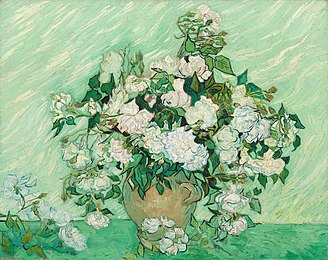impasto
Jump to navigation
Jump to search
See also: impastò
English[edit]
Noun[edit]
impasto (countable and uncountable, plural impastos)

- (painting) The use of a thick-bodied paint to create peaks and crests that physically extend from the surface of a painting.
- 1938, Norman Lindsay, Age of Consent, 1st Australian edition, Sydney, N.S.W.: Ure Smith, published 1962, →OCLC, page 63:
- He was thinking, ʽGot to get a subject where a man can weight the impasto in light. Paint thin against light. Got to remember that.ʼ
- For quotations using this term, see Citations:impasto.
Derived terms[edit]
Translations[edit]
the use of a thick-bodied paint to create sizable peaks and crests in an image
|
Verb[edit]
impasto (third-person singular simple present impastoes, present participle impastoing, simple past and past participle impastoed)
- (painting) To paint in thick-bodied paint; to paint in impasto style.
- 1991, Joyce Nakamura, Contemporary Authors Autobiographical Series, Volume 14[1]:
- "She looked tall to me, and slim, with delicate Semitic features, and a full mouth that she impastoed with red lipstick to play against her […] "
Anagrams[edit]
Italian[edit]
Pronunciation[edit]
Etymology 1[edit]
Deverbal from impastare + -o.
Noun[edit]
impasto m (plural impasti)
Related terms[edit]
Etymology 2[edit]
Borrowed from Latin impastus, from im- (“not”) + pastus, past participle of pascī (“to eat, to feed”).
Noun[edit]
impasto (feminine impasta, masculine plural impasti, feminine plural impaste)
Etymology 3[edit]
Verb[edit]
impasto
Anagrams[edit]
Categories:
- English lemmas
- English nouns
- English uncountable nouns
- English countable nouns
- en:Painting
- English terms with quotations
- English verbs
- Italian 3-syllable words
- Italian terms with IPA pronunciation
- Rhymes:Italian/asto
- Rhymes:Italian/asto/3 syllables
- Italian deverbals
- Italian terms suffixed with -o (deverbal)
- Italian lemmas
- Italian nouns
- Italian countable nouns
- Italian masculine nouns
- Italian terms borrowed from Latin
- Italian terms derived from Latin
- Italian adjectives
- Italian literary terms
- Italian rare terms
- Italian non-lemma forms
- Italian verb forms
